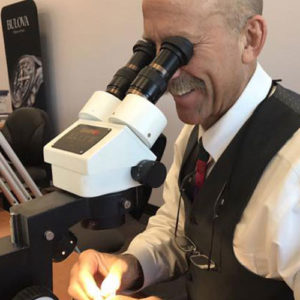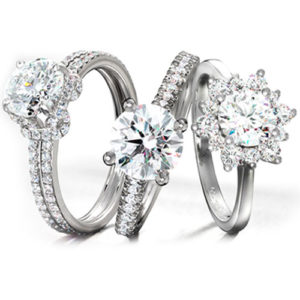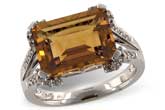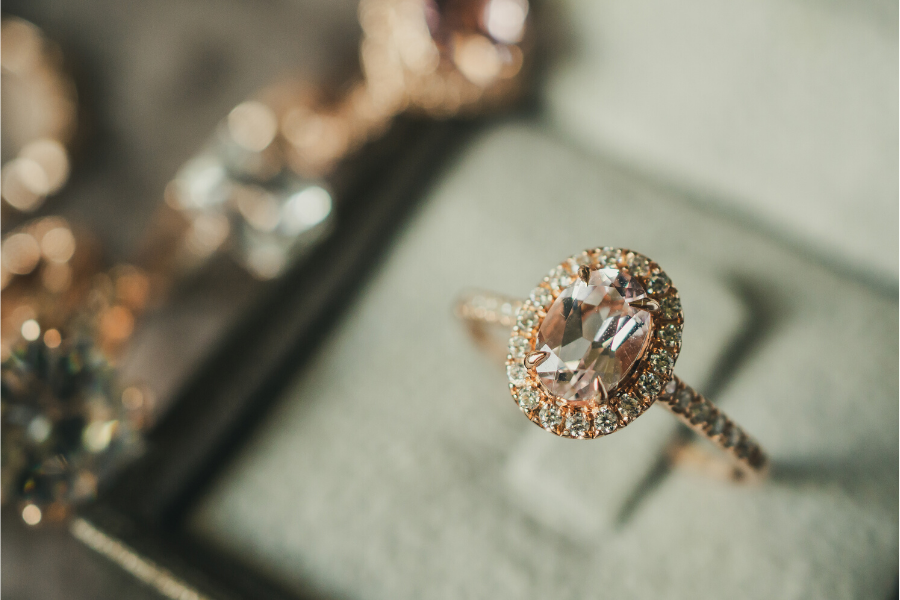Jewelry appraisals are created to verify the value of a certain piece of jewelry. Like a title for an automobile, an appraisal is a document that provides a description of your jewelry, as well as an estimate of it’s worth. But unlike a car, each piece of jewelry created is unique. Therefore each must be appraised individually.
Jewelry Appraisals Include
Neustaedter’s will clean and inspect your jewelry item so that our onsite graduate gemologist can assist in obtaining the following:
- Each Piece of Jewelry will be Measured, Weighed, Graded In Full Detail to Determine the Overall Value.
- Diamonds will be Issued a Evaluation of Authenticity which Includes: Color, Cut, Clarity, and Carat Weight along with Measurements (As Your Item Permits).
- Gemstones will be Identified, Graded, Measured. Weights can be Obtained through Proper Stone Proportion Calculations.
- Metal Types will be Determined. Example, Platinum, Gold (10,14,18, etc…) Karat, or Silver
- Each Appraisal will Feature a Color Photo of Your Jewelry Piece.
An Overall Jewelry Item Description will be Provided to Help you with any claims. Photographs will show Characteristics in order to Assist Jewelry Insurance Claims. Also aids in re- creating a lost or stolen piece.
creating a lost or stolen piece.
Additional Appraisal Services Available:
- Same Day or Rush Appraisals are Available and will be Performed by Appointment Only and at a Commensurate Cost, Dependent on the Level of Complexity and/or Number of Jewelry Pieces.
- Estate Evaluations: Generally Speaking we can Help Sort Give General Descriptions and Help you Gain a General Knowledge to Assist with Large Quantities of your Jewelry Estate Items. Contact our store at 314-966-4442.
Jewelry Appraisals Are Usually Required for Insurance
Insurance is one of those things that we don’t think about until we need it, usually after an accident or loss through theft or natural disaster. Once the need arises, we may feel “let down” by what coverage we actually have on our most valued and sentimental items. This article will provide some basic information on how to best protect yourself and those prized jewelry pieces against lack of accurate insurance coverage.
The only times we think about insurance on our jewelry is usually when we purchase jewelry and need to insure it, and when we suffer a loss due to theft or an unfortunate circumstance. When changing insurance companies or moving into a new home, the issue may also arise. Unfortunately if the jewelry is lost, damaged or stolen, it is too late to address the issue of whether the items were properly covered, and what type of coverage we initially desired.
The logical starting point is to make sure there is an accurate and up to date appraisal on each item we would want to insure. Again, every piece of jewelry is unique. This necessitates a very detailed appraisal with a thorough description and photos to document the piece and it’s condition.
Neustaedter’s Appraisals
Our appraisals at Neustaedter’s have all of the elements required to replace the jewelry if it is lost or stolen. This will include a break down of the type of metal(s) used and a breakdown of all of the gemstones as well. A more involved piece may require a page long description with multiple photos to document piece, it’s construction and style. The ultimate goal is to give enough information, both descriptive and photographic, so the piece can be re-created if the need arises. This information will also give an accurate dollar amount for coverage and replacement.
Common Misconceptions
There are some common misconceptions about jewelry values and appraisals. The most common is that the value always goes up. Like most items, the dollar value is dependant on market forces such as raw material prices, and the effect of supply and demand.
Metals – For the former, we all know that precious metals such as gold, silver and platinum all fluctuate with the market. Right now, gold is around $1300 an ounce. It changes depending  on demand, global economic trends and even apprehensions over a future stock market change.
on demand, global economic trends and even apprehensions over a future stock market change.
Diamonds – Diamonds can also vary quite a bit. Some periods see certain shapes become very popular and more in demand. This creates an upward price trend for that shape, once the demand tapers off, the price may show a downward trend.
How the Value is Determined
A fine piece of jewelry is more than just the sum of its parts. Like artwork, the experience, skill and talent of the designer has a huge influence on the price of the piece. A painting may have a 25 dollar canvas and 50 dollars in the oil paint used, but sell for hundreds of thousands of dollars. Like art, jewelry is an expression of the person creating the piece. More demand for the works of a particular designer will also have an upward effect on the price of that designers work. All of this has to be evaluated and taken into account by the appraiser.
The ultimate goal of the appraiser is to give a comprehensive description of the piece, so that it could be accurately re-created if lost or stolen. As with most things, the old adage ” You get what you pay for” holds true with appraisals too. You can always get a service cheaper, but for the small initial investment in a professional appraisal, the hassle and fuss avoided later on is more than worth the cost.
Most Insurance Companies Require Jewelry Appraisals
Most insurance companies will request you keep an updated appraisal on file, five years seems to be the recommended time for a new appraisal. At Neustaedter’s we keep the original appraisal on file, so the update later on will only be a $25 charge.
Prior to beginning the appraisal, your jewelry will be thoroughly and professionally cleaned. This is included in the appraisal charge. The cleaning is necessary for us to accurately gage the quality of the gems used in the piece. Very small differences in the quality of the gemstone can have a huge impact on the rarity and value of the gem.
For instance, the clarity of a diamond may look identical to its neighbor when viewed with the naked eye. But when put under a Gemscope, variations may arise that make one diamond twice the value of the one next to it. Very small differences in gemstones can have a huge impact on their value. This holds true for your colored gems, such as Sapphire, Ruby and Emerald also.
Colored Gemstone Appraisals
Colored gems have their own unique issues. There are many colored gems that look the same. Some have the same color and tint, but have very different origins, chemical composition and rarity. There is a long process by which colored gems are identified and graded. To do this accurately takes years of experience, training and the right equipment.
and rarity. There is a long process by which colored gems are identified and graded. To do this accurately takes years of experience, training and the right equipment.
Even the area of origin can have a big impact on the value of the gem. For example, Burmese Rubies are highly sought after and valuable. Very few Rubies are Burmese in origin, so establishing this has a big impact on replacement value. An appraiser needs to be able to establish the provenance of the gem for an accurate valuation.
Natural or Enhanced?
Another question that needs to be addressed is, “has this gem undergone treatment to enhance its appearance?”. Colored gems have traditionally undergone a myriad of treatments to enhance their beautiful appearance. Emeralds are routinely “oiled” with substances that fill the fissures, inclusions so that the clarity of the Emerald is enhanced. Sapphires and Rubies are routinely heat treated to give them a more intense color.
Some gems, such as Tanzanite get their trademark color from heat treating. Usually, in its “natural” state, Tanzanite is a less than beautiful brownish color. But when heated to a specific temperature it changes into its trademark deep blue-ish purple color. Tanzanite can also come in a natural greenish color that is very rare and exceedingly valuable. So if a green gem in a ring comes to an appraiser, there are probably close to a hundred different things it could be, and it’s now the job of the appraiser to determine the gem, it’s quality, if it’s been treated and the value of the gem.
Lab Created Gems
Another issue is the advent of lab created gems, including diamonds. Technology enables us to “grow” all kinds of gems in the controlled conditions of a modern laboratory. For all practical purposes these are visually, chemically and identical physically to those that come out of a mine. Again there are huge price variations between most lab grown and mined gems. This is the responsibility of the appraiser to determine the origin of the gem and it’s resultant value.
Be an Informed Jewelry Insurance Shopper
Most people are under the impression that it is covered by their homeowners policy. Because jewelry is easily lost, stolen and misplaced, the average coverage for jewelry under a homeowners policy is around $1500, and you usually have a $250 to$500 deductible. This doesn’t cover very much. For the jewelry to be accurately covered, a “rider” needs to be attached with the specific pieces of jewelry “itemized” on a line basis. This allows the scheduled jewelry to be covered for its appraised value.
Jewelry Insurers
There are companies, such as Jewelers Mutual, that only insure jewelry. The advantage to this is, if you have a loss on jewelry, your other policies, car, homeowners, etc., don’t also increase. Jewelers Mutual will also give you the option to cover damage to the covered jewelry. That is something that the larger companies will not offer. The key here is to be an informed insurance shopper. Get all of the information on your options before making a choice, and base your decision on what is most important to you.
Ask Questions!
The responsibility is yours. A really good insurance agent will inform you as to what is and isn’t covered under your umbrella of coverage. Very often, jewelry doesn’t come up in the conversation. Make sure you know what you have covered and how much it is covered for. Make sure you are comfortable with your coverage in case the unthinkable happens. And, ask questions.
We are always available by phone or email to assist if questions arise.

